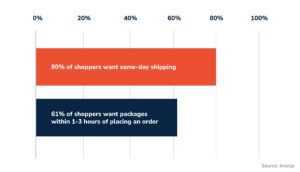Many retailers have already adjusted their approach to shopping and merchandising, introducing powerful omnichannel technologies to streamline operations and help them better compete in a new digital landscape. This could be the secret weapon needed to stay afloat during these uncertain economic times.
Innovative retailers can stay ahead of the competition by making informed predictions and taking action based on those predictions. To successfully future-proof their retail strategies, retail businesses must consider evolving customer needs, market trends, and new technologies – such as AI, IoT, and virtual reality.
The retail trends and predictions of 2024 include the following:
- Hybrid seamless shopping is here to stay
- Retailers improve efficiency with AI
- Gen Z and Alpha are reshaping retail commerce
- Resale boom
- Optimizing fulfillment
1. Hybrid seamless shopping is here to stay
Hybrid shopping stands as a pivotal factor in the evolving retail trends, blending the ease of online shopping with the in-store experiences of brick-and-mortar stores. This innovative approach gives customers the freedom to choose between in-person shopping and remote purchasing, tailoring a personalized shopping journey that adapts to individual preferences.
Hybrid shopping reshapes the dynamic between retailers and the consumer by serving as a bridge between digital and physical channels. This encourages a customer-centric approach in line with current retail trends.
Adopting the hybrid shopping model empowers you and your team to deliver seamless customer experiences across diverse platforms and devices. This positions you ahead of the competition, showcasing your commitment to staying up to date with the dynamic retail landscape and strategically planning for its constant evolution.
2. Retailers improve efficiency with AI
The integration of artificial intelligence (AI), particularly generative and predictive AI, is transforming how customers and associates interact within the retail industry.
With predictive AI, you can analyze vast datasets and forecast future trends. Many retailers are leveraging predictive AI algorithms to anticipate customer preferences, optimize inventory levels, and strategize pricing. Generative AI creates dynamic and personalized content, such as tailor-made product recommendations and virtual try-on experiences.
The combination of the two not only refines the accuracy of recommendations but also empowers you with insights that enhance decision-making processes. This leads to a significant increase in customer satisfaction and loyalty. In fact, over 60% of business owners believe AI will improve customer relationships.
Customers, in turn, benefit from a more intuitive and personalized shopping journey, with predictive AI anticipating their needs and generative AI crafting engaging and relevant content. As you navigate the ever-changing retail trends, the integration of AI becomes vital to staying at the forefront of innovation and meeting the expectations of consumers.
3. Gen Z and Gen A are reshaping retail commerce
Generation Z (also known as Zoomers or Gen Z for short) and Generation Alpha (Gen A) are rapidly growing age groups that are taking the world by storm. They are outspoken and expect brands to act in line with their beliefs, which has resulted in 30% of Gen Z customers making purchase decisions based on a brand’s social and political values.
Experts are reporting that Gen A, the youngest generation, is set to significantly impact the retail industry. Born from 2010 onward, social media is a way of life for these consumers.
The best way for you to win over Gen A is through social media platforms like TikTok, where 60% of Gen Z and a growing number of Generation Alpha use it globally. Craft engaging, raw content to build trust, relying on endorsements from loyal customers instead of traditional ads. Embrace video commerce tools like Firework for visually compelling product presentations, aligning with the preferences of both generations.
Brands are increasingly turning to social media influencers who create user-generated content (UGC) on platforms such as Instagram and TikTok, creating relatable content for consumers.
Collaborating with influential social media influencers who have a loyal fan base is a strategic approach to reaching a much bigger audience. According to Tintup’s report, 93% of marketers agree that customers trust content created by people more than brands.
Urban Outfitters is one retailer taking advantage of this trend by creating its own UO Community blog with subjects such as “How do you UO?” and “Community Cares” to further promote the brand. Social influencing can have both a purposeful and viral effect, boosting sales in store and online & highlighting the importance of customer loyalty & influence in promoting products.
Next year, U.S. retail social commerce sales will total $82 billion, growing 23.5% YoY. Gen Z will likely be driving this growth as they are more likely to make purchases via social platforms than the overall population. This underlines the importance for you to not only understand the preferences and behaviors of Gen Z but also to adapt their marketing strategies.
Integrating social commerce into brand promotion on platforms like TikTok can be a game-changer, aligning with the preferences of both Gen Z and Generation Alpha and tapping into the projected growth in retail social commerce sales.
4. Resale boom
The anticipated surge in resales for 2024 reflects a broader shift towards recommerce, a trend that is not only reshaping consumer habits but also the economic landscape of the retail sector.
As financial and sustainability concerns are on the minds of many consumers, recommerce emerges as a strategic response to meet evolving expectations. The recommerce sector is anticipated to hit the $245 billion mark by the end of 2024.
The founder of Recurate, a platform that helps brands build their own resale marketplaces, says that the resale market is growing 11x faster than regular retail.
In fact, many brands have already started launching resale efforts. Lululemon recently launched its own resale platform called “Like New.” This initiative allows consumers to trade in their used Lululemon gear for credit, and they refresh it for someone else to buy.
By refreshing and reselling these items, Lululemon not only extends the lifecycle of its products but also minimizes environmental impact. The pledge to donate all profits to sustainability efforts further demonstrates how brands can integrate resale not just as a business strategy but to actively contribute to larger societal and environmental goals.
This retail trend of recommerce isn’t just a financial opportunity; it’s a strategic move towards aligning business practices with the growing demand for sustainability. By tapping into this market and adopting strategies, you are contributing to the broader shift towards a more sustainable world.
5. Optimizing fulfillment
In 2024, a retail trend is emerging within the industry, emphasizing the optimization of fulfillment processes. This is spurred by various factors, including the significance of efficiency and customer satisfaction.
One key driver is the ever-increasing demand for seamless and expedited delivery experiences. With the rise of online ordering and the expectations set by industry giants like Amazon and Target, consumers now anticipate swift and reliable order fulfillment. About 55% of shoppers say they’ll change retailers in order to get their delivered quicker.
To meet these evolving demands, retailers are turning to advanced technologies such as AI, machine learning, and automation to streamline their fulfillment operations. These technologies not only enhance the speed and accuracy of order processing but also enable retailers to adapt to fluctuating demand patterns, contributing to a more agile and responsive supply chain.
Not only do consumers want speedy delivery, but a vast majority want same-day delivery. Nearly 80% of shoppers surveyed want same-day shipping, while 61% want their packages even faster – within 1-3 hours of placing an order.
In essence, optimizing fulfillment has become a strategic imperative for retailers looking to stay ahead in a dynamic and competitive marketplace, making it a prominent trend in the retail tech industry in 2024.
This shows the swift evolution of consumer demands, highlighting their expectation for speedy order fulfillment, a standard set by industry giants. This expectation significantly shapes their purchasing decisions and ongoing loyalty to your company. It is crucial that you align with this trend promptly and initiate expedited shipping to meet these changing consumer expectations.
Embracing the future of retail
By actively embracing these trends, retailers position themselves not only to meet current consumer demands but to lead the way in shaping the future of the retail industry. We anticipate these trends such as social commerce and hybrid shopping to continue to grow in 2024 as the retail industry scales with it.
Additionally, advancements with AI will revolutionize retail technology and take personalized shopping experiences to new heights. Find what works best for your store and embrace the transformative power of these retail trends to stay ahead in the competitive market.








